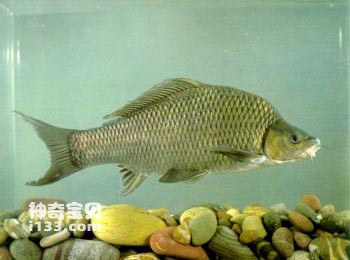Procypris rabaudi belongs to the order Cypriniformes, family Cyprinidae, subfamily Cyprinidae, and genus Procypris rabaudi. Commonly known as: rock carp, black carp, rock carp, black carp, water carp, ghost head fish. English name: Rock carp.
Endangerment level: Vulnerable.
The sides of the body are flat and diamond-shaped, the back is bulged into an arc, and the abdomen is round. The head is small and conical, the snout is pointed, and the snout length is shorter than the head length behind the eyes. The mouth is sub-inferior and horseshoe-shaped; the lips are thick and there are inconspicuous papillary protrusions on the lips, which are completely absent in small fish. There are 2 pairs of barbels, the rear pair is slightly longer than the front pair, and the fish eye diameter is about the same length. Big eyes. The lateral line is straight and has 43-45 lateral line scales. The dorsal and anal fin spines are particularly strong, and the trailing edges are serrated. The outer edge of the dorsal fin is straight, the base is long, and the branched fins are 18-21; the starting points of the dorsal and pelvic fins are opposite. The pectoral fins are long, ending at the beginning of the pelvic fins. The head and back of the body are dark black or black-purple, with a slight bluish-purple luster, and the abdomen is silvery white. There is a black spot on the back of each scale. There is a black edge on the trailing edge of the caudal fin. During the reproductive period, the fins of the male fish are dark black and there are pearl stars on the head.

Iwahara carps mostly inhabit the bottom of rivers with slow currents and rocky bottoms. They often appear between rocks. They spend the winter in caves or deep ponds on the river bed. After the beginning of spring, they start to swim upstream to various tributaries to lay eggs. The minimum maturity age is 4 years old, the spawning period is from February to April, and the peak spawning period is from February to March. According to fishermen, there are also activities of spawning broodstock in autumn (August-September). Spawning grounds are generally located under the rapids of tributaries in second-flow water with gravel bottom. The eggs are light yellow. After they are laid, they adhere to stones and develop. The growth rate is slow, and generally only 4-year-old fish can reach about 0.5 kilograms; the body length of 10-year-old fish is 59 cm and the weight is 4 kilograms; common individuals are 0.2-1.0 kilograms, and the largest individual is recorded to be up to 10.0 kilograms. Although it is an omnivorous fish, it prefers to eat benthic animals. Its main food ingredients are chironomid larvae, Ephemeroptera and Trichoptera larvae, oligochaetes, small snails, clams, freshwater shellfish and other molluscs, followed by Decayed fragments of higher plants and occasionally a few phytoplankton. Feeding stops in winter, begins to increase from March to April, and begins to feed in large quantities from July to August.
Distributed in the main tributaries of the upper reaches of the Yangtze River. In the fishery in the upper reaches of the Yangtze River, the economic value is relatively high. The yield is not high, but it has the advantages of small body cavity, tender meat, and delicious taste. It is loved by people and is a medium-sized, high-quality economic fish.
In recent years, dams and gates have been built on tributaries of the upper reaches of the Yangtze River, blocking the migration path of Iwahara carps to their spawning grounds. In addition, high-intensity fishing, especially large-scale electrofishing, has extremely serious damage to its resources. In addition, sewage discharge from factories along the river has affected the water quality. Affected by dangerous factors such as deterioration, the growth rate of this species of fish is relatively slow, and the population cannot be replenished in time, so the wild population is tending to decrease year by year.
animal tags: Cyprinidae
We created this article in conjunction with AI technology, then made sure it was fact-checked and edited by a Animals Top editor.